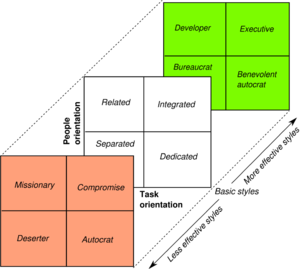Reddin's basic management styles
Reddin's basic management styles (also called Reddin's leadership styles) define the extent to which the manager is focused on people, tasks and efficiency. Concept of W.J. Reddin is a development of the two dimensional management style classification of R. Blake and J.S. Mouton, on the basis of which he created his own called Reddin's box.
He describes three basic dimensions (three types of management styles):
- Task orientation
- People orientation
- Focus on efficiency
Basic styles
Reddin's box contains four basic styles in the middle of the efficiency continuum, four styles on the high efficiency side and four on the low efficiency side (fig. 1.). Most common management styles are:
- Separated style - characterized by low concern for people and tasks, and moderate concern on efficiency.
- Bureaucratic style - focuses only on efficiency. Manager closely observes the principles and the provisions adopted company and acts only within the framework of the adopted rules. He surrounds himself with such administrative positions, where efficiency is hardly measurable,
- Missionary style - this manager focuses only on contacts with people. Manager takes care of a friendly relationship with the employees, doe not hinder their job. He believes that happy people are more efficient, hence manager should care more about a pleasant atmosphere in the team, than on efficient performance. Problems are solved through discussion. Disadvantage of this management style is low efficiency.
- Developer style - manager focus on high effectiveness and good contact with people. He also believes that the working atmosphere is conducive to efficiency and developing skills of people. He can encourage subordinates to give more of themselves, but also requires more from them - in this regard, such manager differs from the missionary manager,
- Autocratic style - is characterized by high concern for production and efficiency, and a little focus on people. First, the manager expects subordinates absolute obedience and supervises them to comply with their duties to his satisfaction. Secondly, does not take into account good relations with people,
- Benevolent autocrat - is focused on efficiency and good relations with people. From classic autocrat it differs in that the manager can have high requirements, but does not create a tense atmosphere within team,
- Compromise style - is characterized by high regard on people and tasks. Manager believes that planning should be based on compromise, then it will be possible to attain optimal performance. In practice it is not possible to find the right balance between the tasks and the people, because it shall take decisions under the pressure of facts or the environment,
- Executive style - is oriented on people, tasks and high efficiency. Manager sets ambitious objectives for the employees and require high performance, but also maintains good contact with them. The manager is engaged in the duties performed by the employees and the problems of subordinates by giving them an incentive to work. Is open to new ideas, allows employees to co-create of work plans, because he knows that in this way they can take more active part in the work. He knows that people form an organization.
Reddin believed that the executive style is the best, and the person using can be called "real manager". Currently, it is believed that this is the best manager that has knowledge of all styles of management and can choose the right one depending on the specifics of the organization and the external situation.
See also:
- Management styles
- Blake and Mouton managerial grid
- Lewin, Lippitt and White - basic styles of management
Reference
- McGregor, D. (1960). The human side of enterprise. New York, 21(166.1960).
- Reddin, W. J. (1970). Managerial Effectiveness, McGraw-Hill Book Company, New York
- Reddin, W. J. (1977). An integration of leader-behavior typologies. Group & Organization Management, 2(3), 282-295.
- Tannenbaum, R., & Schmidt, W. H. (1973). How to choose a leadership pattern (p. 3-12). Boston, MA: Harvard Business Review.
| Reddin's basic management styles — recommended articles |
| Qualifications of directors — Principles of organization — Theory X and Y — Leadership models — Hersey and Blanchard model — Levels of leadership — Organic organization — Effects of culture — Blake and Mouton managerial grid |
